CDFW Environmental Scientist Erin Tennant lives and works out of her hometown of Bakersfield. She is assigned to CDFW’s Lands Program, where she assists CDFW’s Central Region in the management of tens of thousands of acres of wildlife habitat in 12 counties in the middle of the state.
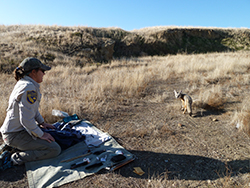 Erin gets some hands-on experience working with a San Joaquin kit fox.
Erin gets some hands-on experience working with a San Joaquin kit fox.
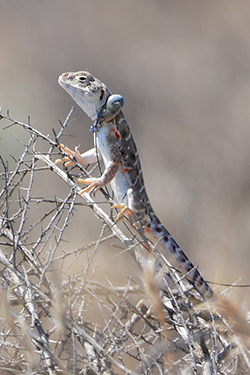 Tiny radio collars are affixed to blunt-nosed leopard lizards as part of CDFW’s research into the lizards’ habitat preferences on several San Joaquin Valley ecological reserves where they are found.
Tiny radio collars are affixed to blunt-nosed leopard lizards as part of CDFW’s research into the lizards’ habitat preferences on several San Joaquin Valley ecological reserves where they are found.
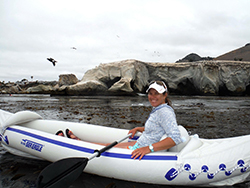 Kayaking near Pismo Beach.
Kayaking near Pismo Beach.
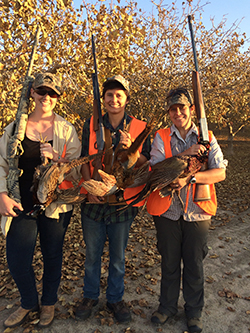 Erin participated in a 2014 CDFW Kern County women’s pheasant hunt as part of her ongoing effort to develop her hunting skills.
Erin participated in a 2014 CDFW Kern County women’s pheasant hunt as part of her ongoing effort to develop her hunting skills.
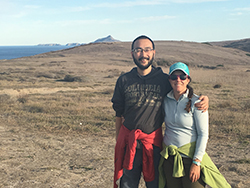 Erin and her husband, John Wang, enjoy a hike on Santa Cruz Island off the Southern California coast.
Erin and her husband, John Wang, enjoy a hike on Santa Cruz Island off the Southern California coast.
CDFW Environmental Scientist Erin Tennant lives and works out of her hometown of Bakersfield. She is assigned to CDFW’s Lands Program, where she assists CDFW’s Central Region in the management of tens of thousands of acres of wildlife habitat in 12 counties in the middle of the state.
Erin holds a bachelor’s degree in biology and environmental studies from Whitman College in Washington and a master’s degree in biology from California State University, Bakersfield, where she studied the Tipton kangaroo rat for her graduate thesis.
What prompted your interest in science and the outdoors?
I became interested just by being young and inquisitive about the natural world. I grew up in suburbia, but I spent a lot of time as a kid working in the garden with my mom. My mom was a second-grade teacher and used to take her classes on annual trips to visit spring wildflowers and, of course, I would join. I also was a horse-crazy kid and thought for a long time that I wanted to be a veterinarian. From about age 10 on, you could definitely find me at the horse barn after school and on weekends. I rode competitively, but I’d also just go out on rides with all my friends through the agricultural fields. I just loved being outside. I had no idea “wildlife biologist” was a career until I entered college and started taking environmental studies courses.
Who or what brought you to CDFW?
I got my start as a biologist when I was home on spring break from college and had a dentist appointment. I was in the waiting room and there was this Smithsonian magazine with a big feature story on the San Joaquin kit fox and all the research work a group called the Endangered Species Recovery Program was doing in Bakersfield. I was just shocked. That was exactly the kind of work I wanted to do and it was happening right here in my hometown. I started Googling all the people in the article and started e-mailing them and asking about internships and other opportunities to just volunteer and help out. It worked. I spent two summers working as an intern for the Endangered Species Recovery Program in Bakersfield and made all kinds of great connections and relationships as a result.
When I graduated from college and eventually returned to Bakersfield, Ellen Cypher, a former CDFW botanist in Fresno, was looking for a scientific aide. She hired me in 2006. I was working for CDFW and at the Endangered Species Recovery Program at the same time until I got a contract position with CDFW in 2007. I was hired permanently as an environmental scientist for the Lands Program in 2011.
What do you like best about your job?
I really like the diversity. No day is really the same. We’re always working on new projects and have focused on research the last few years. I like to say that our Lands Program in the Central Region straddles many different department priorities – land management, threatened and endangered species conservation, non-game species conservation and even habitat conservation planning. There are endless opportunities available for restoration, research, outreach and even recreation on ecological reserves, which means that there are endless opportunities for professional growth, too. Plus, our unit is always trying to be innovative and adaptive in how we do things. With very limited budgets and personnel and a huge area to cover, this often requires a lot of creativity.
What interesting projects are you working on currently?
One project I have been working on the last three years is the blunt-nosed leopard lizard, which is a federally listed and state listed endangered species. We’re looking at their population size, demographics and space use on our ecological reserves to try to figure out how to better manage the reserves for them.
I have met lots of people who do not like lizards – maybe they think they are ugly and spiny – but blunt-nosed leopard lizards are very charismatic, beautiful lizards. In total length they can be over a foot long and they are active during the day. They especially like the early mornings in the Valley before it gets too hot. They’re really striking in their full breeding colors. Females have bright orange spots and males turn a salmon color throughout their bodies. They’re really fun to watch during the breeding season.
I also have been working on a statewide Swainson’s hawk survey. We’re gearing up for a big survey year and I’m helping to lead the San Joaquin Valley effort.
What should we know about the Swainson’s hawk?
They’re a state-threatened species, and we’re conducting the first formal population survey in 10 years. It’s a team effort, and we are collaborating with Region 2 and our statewide raptor coordinator, Carie Battistone, to complete the survey. At least in the San Joaquin Valley, it seems like we are seeing more Swainson’s hawks, but we need data to determine if our suspicions are accurate.
They’re fascinating because they breed throughout Central Valley but they spend their winters in South America, primarily in Argentina. They are readily able to use some of the agricultural areas around the San Joaquin Valley to find food, breed and rear their young. Then they make an incredible migration – they are one of the few raptors to migrate so far. They form these huge groups, called kettles, in the fall, especially in the agricultural fields like alfalfa, and there will be hundreds of these hawks flocking and foraging together in preparation for their migration. It’s amazing to watch.
It sounds like there may be more wildlife and habitat around Bakersfield than the average Californian realizes.
I grew up in Bakersfield, and one of the reasons I wanted to come back here was because I felt drawn to contribute to the conservation of local wildlife around my hometown. Growing up here, you hear a lot about agriculture and how this area is one of the top-producing agricultural areas in the world. But you don’t learn much in school – at least I didn’t – about the native wildlife and their habitats. One thing that struck me during my environmental studies field courses in college was that very few biologists stay in one place long enough to know and understand that place. After going away to college and traveling a ton after graduation, I was ready to come back to Bakersfield and contribute to environmental conservation in my hometown.
I think what’s unique about this area is that it really is a desert and, because of our geography, we have many endemic species. When you get down to the habitats, you see that all the species found here are desert-adapted. We have species such as the Bakersfield cactus, kangaroo rats, blunt-nosed leopard lizards and kit foxes. These are all species also found in places like the Mojave Desert. Desert ecosystems are very fragile and there are so few places around Bakersfield where you can see really what would’ve been – what the San Joaquin Valley would have looked like without development and without agriculture – that I think protecting those places and learning about those places and encouraging other people to get to know those places is really important.
Can you point us to a place where someone might see what the San Joaquin Valley looked like long ago?
One place that I always recommend to visit is the Carrizo Plains – both the Carrizo Plains National Monument and the Carrizo Plains Ecological Reserve. It is a great place to get a glimpse of what the San Joaquin Valley might have looked like historically. It’s a really beautiful place, especially in the spring. In wet years, there are lots of wildflowers to see. There are several overlooks in the area, and I love to go where you can stare down on the valley floor below and imagine what the San Joaquin Valley looked like before agriculture. It’s great to have that area protected.
Tell us something about yourself many people would be surprised to learn.
Most people are surprised to learn that I lived in China for two years. After I finished my undergraduate degree, I joined an exchange program through my college and taught English at Northwest Polytechnical University in Xi’an, which is in the center of China. I met my husband there, and after a very long and winding journey, which involved many years of long-distance, we eventually landed in Bakersfield together two years ago. Our family grew this fall with the birth of our son, Kian.
Erin Tennant Photos. Top Photo: Erin holds a great horned owlet that was banded as part of a raptor research project in the Tehachapi Mountains.